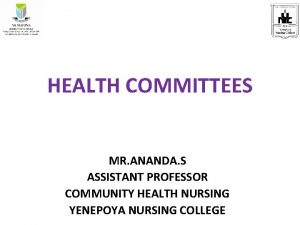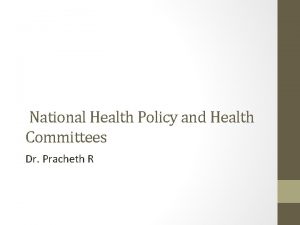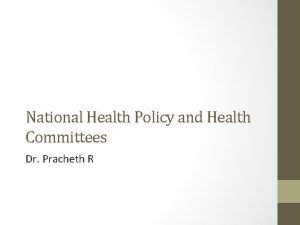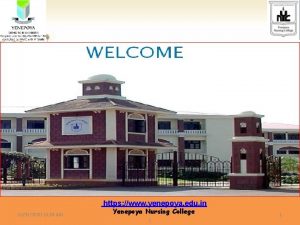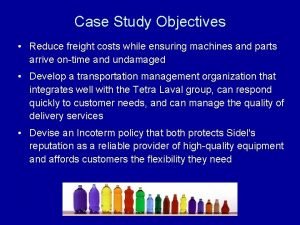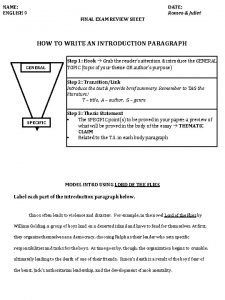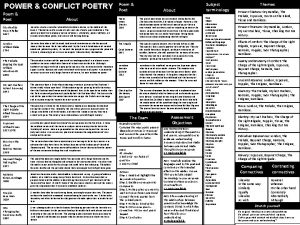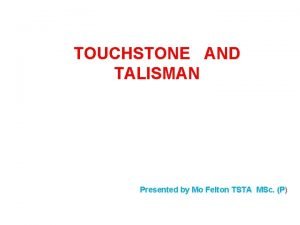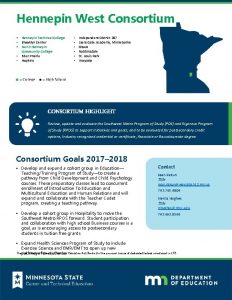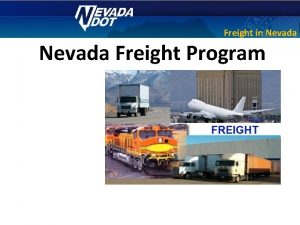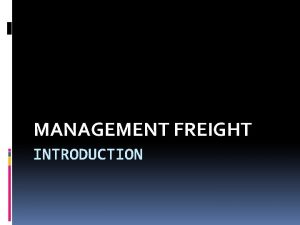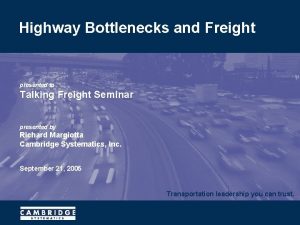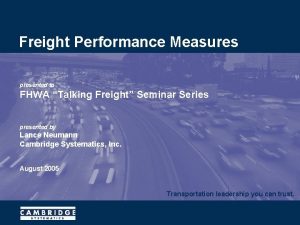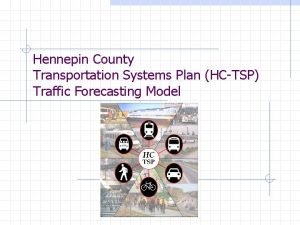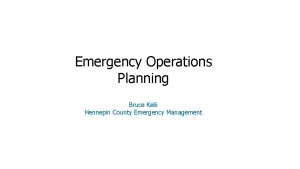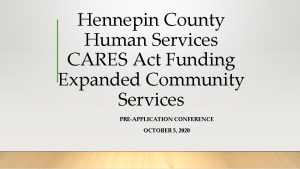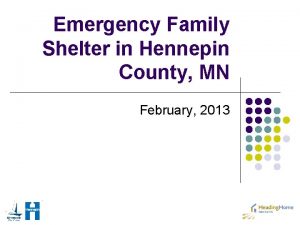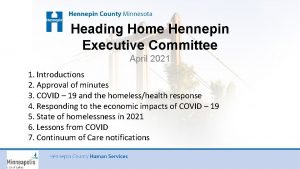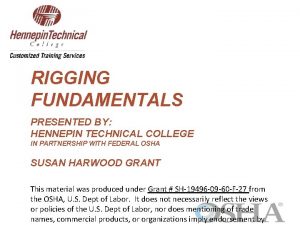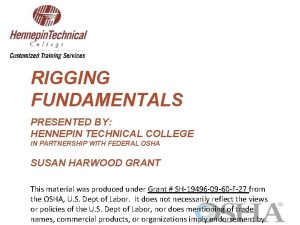Hennepin County Freight Study Committee Final Recommendations presented

































- Slides: 33

Hennepin County Freight Study Committee Final Recommendations presented to presented by Hennepin County Public Works Cambridge Systematics, Inc. Elaine Mc. Kenzie December 1, 2016 1 Andreas Aeppli

Agenda Welcome and Introductions Freight Study Overview Key Study Findings Recommendations 2

Freight Study Overview 3

Freight Study Goals How does freight move in Hennepin County » What are the primary origins, destinations, routes, and clusters of freight and freight-generating activity? Identify key trends in freight activity » Who is using the system now, and what changes can be expected in the future? How does the County’s freight system perform » What actions can the County take to support efficient freight movement? 4

Freight Study Scope and Schedule • Infrastructure and Network Use Task 1 • June, 2016 • Commodity Flow Analysis Task 2 • August, 2016 • Truck System Performance Task 3 • October, 2016 • Findings and Recommendations • December 2016 Final 5 5

Key Study Findings 6

Use of the County Freight System - Highways Trucks move 83 percent of goods in Hennepin County, by weight Provide first- and last-mile connections. Heavy county road volumes: » Routes that parallel key state/interstate routes (61 and 81) » Lake Minnetonka area (15, 19, and 110) 7

Use of the County Freight System - Rail 172 track miles of freight rail infrastructure in Hennepin County » 90 percent owned by CP, BNSF, and UP » Mainly through traffic CP’s Humboldt and Shoreham railyards both served partially by County roadways 8

Use of the County Freight System – Policy Concerns Primarily national or state issues » Labor shortages » Safety regulations » Truck size and weight limitations » Truck Tolling 9 Key local concern is de-industrialization of the urban core. » Increasing development pressure » “Highest and best” land use » Mis-match between residents and jobs

Safety – Truck Crashes 893 truck-involved crashes on County Highways (2010 – 2014) » 3 fatalities and 208 persons injured Crash rates similar to the state as a whole Fatalities: » 6 (6 th Ave) and 112 (Wayzata Blvd) » 101 and TH 7 » 46 (East 46 th Street) and 33 (Park Ave) 10

Areas of Heavy Freight Activity on the County Highway Network 11

Truck Congestion on the County System Truck congestion occurs both with and separate from general congestion areas Reliability issues: » High truck congestion on County Roadways 109, 9, 61, 1 » Congestion around major intersections – § § 12 9 and U. S. 169 61 and I-494 61 and CSAH 9 / TH 55 81 and I-94, TH 610 and U. S. 169.

Areas of Freight Activity 59 economic clusters (DEED) Industrial employers comprise 1, 500 firms and 57, 000 employees in the County Number of Employees by Cluster Type Activity; 5 539 Major; Professio 9 526 nal; 12 017 Diversified; 28 337 Industrial; 57 233 Source: Minnesota DEED 13

Freight Intensive Industries No. Businesses in Hennepin County by Industry 6 000 5 000 4 000 3 000 2 000 1 000 - 5 178 3 525 3 718 1 365 462 38 Agriculture, Mining, Construction Manufacturing Forestry, Quarrying, and Fishing and Oil and Gas Hunting Extraction Wholesale Trade Retail Trade Transportation and Warehousing No. Employees in Hennepin County by Industry 120 000 100 000 80 000 60 000 40 000 20 000 - 14 95 637 79 404 45 202 29 901 1 546 253 Agriculture, Forestry, Fishing and Hunting Mining, Quarrying, and Oil and Gas Extraction Construction 21 848 Manufacturing Source: Dun and Bradstreet Hoover’s Business Data (2014) Wholesale Trade Retail Trade Transportation and Warehousing

Hennepin County Total Tonnage Projected to grow 33% by 2040 Mode Share by Tons (in millions of tons) 15 2014 2040 (Projected) 828 million tons 1. 1 billion tons

Hennepin County Freight Value Projected to Grow by 118% Mode Share by Value (in millions of dollars; excluding through traffic) 2014 2040 (Projected) $103 billion 16 $225 billion

Top Trading Partners Top Domestic Trading Partners by Total Tonnage and Mode, in Millions of Tons, 2014 Ran k Highway Trade Partner Rail Ton s Trade Partner 1 Rest of Minnesota 2 Iowa 3 Wisconsin 5 Mountain 4 East North Central (Chicago) South Atlantic 3 Pacific 5 17 40 East North Central (Chicago) 5 West North Central 1 West South Central Water Tons Trade Partner 2 Louisiana (all FAF Zones) 1 Buffalo, New York CFS Area 0. 5 Iowa Air Ton s Trade Partner Tons 8 Chicago IL 0. 03 -IN-WI (IL Part) 4 Miami, 0. 01 Florida 0. 2 Los Angeles, CA 0. 5 Cleveland, < Ohio 0. 01 0. 5 Detroit, < Michigan 0. 01 0. 2 0. 4 Chicago, ILIN-WI (IN Part) Los Angeles, California < 0. 01

Primary Highway Commodities Nonmetallic Minerals Farm Products 14 Major Highway Commodities, 2014 (million tons) Secondary Traffic 70 19 147 24 Food or Kindred Products 27 Petroleum or Coal Products 33 109 66 Clay, Concrete, Glass or Stone Chemicals or Allied Products Waste or Scrap Materials 77 97 Lumber or Wood Products Primary Metal Products 18 All Others

Recommendations 19

Key Freight Study Themes Ensure safety of both freight and passenger transportation within and through the County through targeted policies and investments; Integrate freight into County planning and project development, creating a culture that promotes efficient, effective, and safe movement of goods; Monitor performance of the freight transportation system in a way that supports performance-based planning and effective investments; Cultivate partnerships with public-sector agencies on freight transportation related issues, creating a vehicle to advocate for the County’s needs and contribute to projects benefiting Minnesotans in and out of the County; and Support economic vitality in Hennepin County through continued outreach, partnership, and support to businesses. 20

Economic Vitality Cultivate Partnerships Monitor Performance Integrate Freight Recommendation Ensure Safety Recommendations Overview Identify and Prioritize Freight Projects X X X Freight Performance Measures X X X X Freight Data Design for Safe Freight Movement X X Support Freight in the Urban Core Upgrade Road/Rail Crossings X Continue Engaging Freight Stakeholders Identify Areas for Future Study 21 X X X X

Identify and Prioritize Freight Projects 19 upcoming and 4 completed “freight” projects in 2016 – 2020 CIP » Within 1 mile of an industrial cluster » Truck AADT > 500 22

Freight Performance Measures Identify and track freight performance on the County system » Mobility (truck volumes / congestion) » System Performance (pavement condition / obstacles) » Economic Indicators (volumes / value of goods shipped) » Others… 23 Specific County measures should: » Align with ongoing work by Mn. DOT and Met. Council » Track performance on County-owned roadways » Provide information to support local decision making

Freight Performance Measures Draft USDOT Freight Performance Measures » Percent of the Interstate System Mileage providing for Reliablke Truck Travel Times » Percent of the Interstate System Mileage Uncongested Mn. DOT Freight Performance and Economic Indicators: » Annual Hours of Truck Delay (AHTD) » Truck Reliability Index (RI 80) » Heavy Commercial Average Annual Daily Traffic (HCAADT), by corridor 24 » Truck / Rail / Port / Airport volumes and container lifts Met. Council Prioarity Performance Measures for TPP(April, 2016) » Key truck corridors (10 ton corridors) » Truck travel time index » Access of rail-accessible industrial land » Bridge and Pavement Condition

Freight Data Collect and maintain freight data on the County system » Future traffic counters should distinguish heavy trucks » Prioritize data collection on bridge and infrastructure condition Coordinate with Mn. DOT and Met. Council efforts § Track freight performance in and around Hennepin County § Supplement with County level data, as able Re-study the freight system on a periodic basis 25

Design for Safe Freight Movement Land Use Conflicts • “Good neighbor” policies • Plan for increasing truck traffic in growing areas 26 Design/ Streetscape Conflicts Transportation Operations Conflicts • Intersections that allow safe truck movements • Rumble strips, center guardrails, wider shoulders/ turn lanes • Designated loading zones and parking • Signage and signal timing

Advocate for Freight Projects Articulate and support County priorities in Mn. DOT, Met. Council planning and programs NHS Intermodal Connectors » Shoreham Yard – § N 2 nd Street-N Lowry. University Ave 27

County Growth Strategy Freight intensive uses are moving out of the urban core into peripheral regions § Can cause difficult policy decisions when development forces unplanned infrastructure improvements § Increases congestion, truck and passenger VMT § Disconnect between workers and jobs Top 10 freight bottlenecks are in Hennepin County (Mn. DOT) Hennepin County should work with its partner agencies to develop a comprehensive strategy to address these issues 28

Upgrade Road/Rail Crossings Inventory road/rail crossings on County roadways with high freight volumes for truck mobility/safety issues, e. g. lane geometry and clearances Partner with Mn. DOT and Met. Council to advance priority road/rail crossing improvements 29

Continue Engaging Freight Stakeholders in Hennepin County Businesses in Hennepin County… » » Think it is a good place to do business Want better connections to international gateways Want alleviation of congestion/freight bottlenecks Want a focus on freight as overall growth continues Greater. MSP, freight-oriented businesses, and business organizations should be periodically engaged by the County Track long term trends, priorities, and performance 30

Identify Areas for Future Study Corridor-level studies of principal freight clusters » County 61 (Plymouth Road) » County 116 (Fletcher Lane) » State Route 100 and 169 (partner with Mn. DOT / Met. Council) Bridge, clearance and sign inventories Align freight with other planning efforts (within/outside County) and update study peridoically 31

Concluding Thoughts Existing industry and freight-related growth provide both economic opportunity and strain transportation resources Dealing with freight will continue to be a challenge for all transportation agencies This study provides a foundation for Hennepin County to: » Plan for and integrate freight into overall processes » Ensure safe and efficient freight transportation » Prioritize freight-related investments and programs necessary to support future economic growth » Increase data collection and monitoring of County roadways » Coordinate with Mn. DOT, Met. Council, and County stakeholders on freight related issues 32

Discussion and Questions Thank you! 33
 Hennepin county emergency management
Hennepin county emergency management Hennepin county infectious disease manual
Hennepin county infectious disease manual Jj irani committee
Jj irani committee The mudaliar committee was appointed in
The mudaliar committee was appointed in Learning without burden 1993
Learning without burden 1993 In 1959
In 1959 Kartar singh committee recommendations
Kartar singh committee recommendations Kartar singh committee also known as
Kartar singh committee also known as Jvk rao committee
Jvk rao committee Freight cost reduction case study
Freight cost reduction case study Conclusion for project report example
Conclusion for project report example World history final exam study guide
World history final exam study guide Us history final exam study guide semester 1
Us history final exam study guide semester 1 Noah carried a skateboard
Noah carried a skateboard Romeo and juliet final exam
Romeo and juliet final exam Environmental science final study guide
Environmental science final study guide Civics and economics final exam study guide
Civics and economics final exam study guide Apwh final exam review
Apwh final exam review Physics semester 1 final exam study guide answers
Physics semester 1 final exam study guide answers Us history semester 1 final exam study guide answers
Us history semester 1 final exam study guide answers Zoology final exam
Zoology final exam Pols 1101 final exam
Pols 1101 final exam Us history semester 1 final exam study guide answers
Us history semester 1 final exam study guide answers My father said to me
My father said to me Crosshead in newspaper
Crosshead in newspaper Presenter's name
Presenter's name The strange case of dr.jekyll and mr.hyde setting
The strange case of dr.jekyll and mr.hyde setting Love themes in romeo and juliet
Love themes in romeo and juliet Both passages
Both passages Presenters name
Presenters name Ozymandias narrator
Ozymandias narrator Cognitive learning theory by jerome bruner
Cognitive learning theory by jerome bruner Martha stoddard holmes
Martha stoddard holmes Talisman presented
Talisman presented



